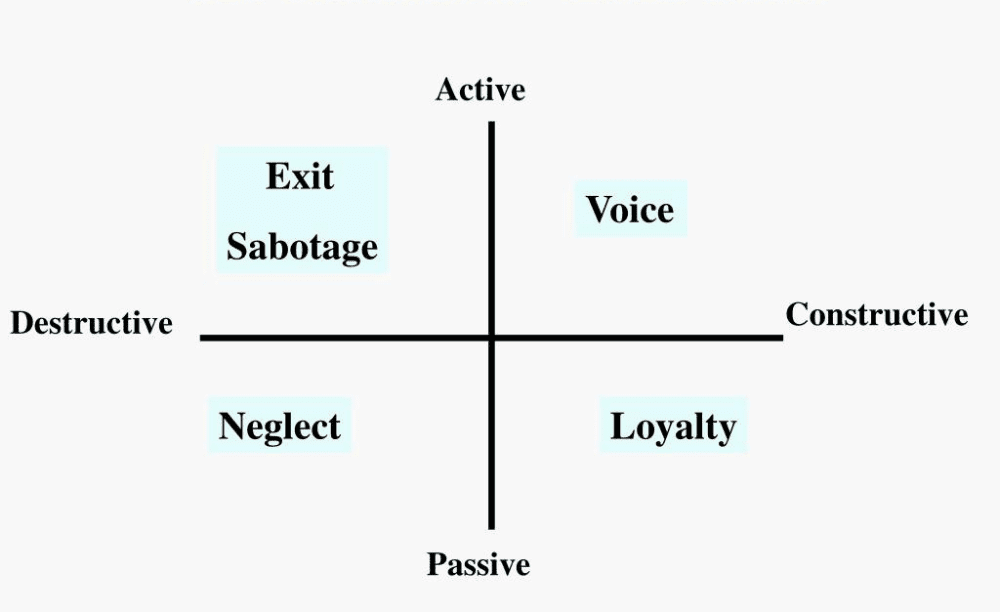“Exit, Voice and Loyalty” is a book, written in 1970 by economist Albert O. Hirschmann. The book attempts to explain two possible responses that individuals (customers, voters and so forth) can make to a service that they find unsatisfactory – ‘exit’ and ‘voice’. ‘Exit‘ is when, for example, a customer decides to stop buying a particular brand of product, visiting a particular restaurant or using a service provider. ‘Voice‘ covers the range of processes that the individual might engage in to communicate their dissatisfaction with the product to the organisation responsible without breaking the relationship (sometimes, as with government-provided services, there is no choice to do so).|

What interested Hirschmann was the increasing focus amongst economists and political scientists on measurements of ‘exit’ – market share, sales figures, opinion polls and so forth, and the sidelining of ‘voice’, which is inherently harder to measure. Or, to put it another way, the focus moved to quantitative measurements that could be reduced to figures in a table and away from qualitative measurements of satisfaction and desired improvements. Hirschmann’s view was that whilst Exit is a good way of measuring success and failure for some goods, it should never be the only measurement. The book attempts to explain how to distinguish between scenarios where measurement of Exit makes sense and others where measurement of Voice is more valuable.
So what does this have to do with web usability? Well, we have a similar distinction: when we’re looking at web analytics, we’re measuring Exit. “Did the customer complete the checkout process?” is a question that’s all about Exit, as is “how many visitors did we have last month?”. When we do user testing, we’re measuring Voice: “what does the customer think and what improvements would they like to see?”. This means that the concepts of Exit and Voice are likely to be useful to us in certain circumstances.
One that struck me recently was the fact that sometimes, Exit isn’t an available option. Intranet systems don’t give the user the choice of using a different intranet, so this makes Voice – user feedback – a much more important mechanism of performance measurement and improvement. Monitoring total visitor numbers on an intranet tells you nothing about how well that intranet site performs. Because of this lack of choice, users will persevere with a system and learn to work around its weaknesses. There may be huge pent-up frustration with a system, but no mechanism to express this.
In contrast, large-scale e-commerce operators will pay close attention to the analytics, which typically consists of Exit measurements. Conversion rates are basically a measure of how many (or few) users Exit the process of buying a product. Analytics can’t tell you what those customers are thinking, but it can tell you what effect this has on your sales figures. Indeed, for competitive e-commerce sites, it’s sometimes better to trust what people do on your site than what they say about it (economists call this ‘revealed preferences’). It’s possible for people taking part in user testing to suggest ideas that they think might be useful at the time, but which don’t really make sense outside of the testing environment.
Finally, Hirschmann also devoted the final chapters of his book to the concept of ‘Loyalty’, explaining why sometimes some people will stick with an inferior service or tolerate declining quality of goods even when better alternatives exist. This is a lot more complicated to evaluate, but it’s also very relevant to usability; for example, it explains why Amazon can get away with breaking the usability rules but their newer competitors can’t. In some situations, for example internal company intranets, the ‘loyalty’ that staff feel towards their organisation or their team might make them less critical of a poor site than they should be.
In summary, these concepts are a useful way of thinking about the usability of different types of systems. If it’s an intranet, user testing and feedback is essential, because you’re not going to get changes in market share to tell you when you’re doing badly. For high-traffic sites or e-commerce, analytics is the first place to look for information about potential usability issues. When looking at any website or system, it’s useful to start by asking which feedback mechanisms are likely to deliver the most benefit, and Hirschmann’s concepts of Exit and Voice are a great way to do that.



![Implement this to your cart pages now [GUARANTEED INCREASE]](https://i.ytimg.com/vi/0nhykafrd_g/sddefault.jpg)
![Implement this to your cart pages now [GUARANTEED INCREASE]](https://i.ytimg.com/vi/DLwJ2jNSVYo/sddefault.jpg)


